The Pubs of Rye no. 5,by David Russell.
The most noted landlord of this public house was Stephen Gilbert Fryman. He first came to light in 1824 when he purchased the Bridge Inn, Winchelsea for £60, and sold it two years later for £116 making a handsome profit. But whether he held the licence as well as being the owner is unknown. What is known is that around 1826 Stephen Gilbert Fryman was in a trading partnership as a wholesale grocer and chandler in Market Street. This business was still listed in Piggot’s Directory for 1840.
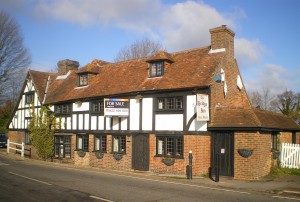
At some point in the 1820s he acquired the premises at 101 High Street, which from the late 17th century to the late 18th century had been in the occupation of the Gill family of clockmakers.
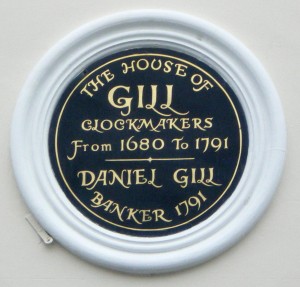
As a response to the Clock Tax of 1797 which increased the price of clocks and watches, many public clocks were erected on both private and public buildings. As you might expect from a clock designed to be publicly displayed, they were often large and solidly built. The Gill family had their own clock mounted on the front of their premises in the High Street advertising their business.
Sometime around 1820 the premises became a public house known as the Black Boy and Still, and later as the Dial or Dial House, obviously indicating the public clock on the front of the building.

Various deeds list some of the occupants and possibly owners of the Dial, but not always the dates of their occupation. A conveyance of 1854 states that ‘it was at one time occupied by Thomas Earl, since of William Payne, since of Sarah Barnes, since of Charles Pilcher, since of Edward Hilder, since of Thomas Bourne, since of Henry Bourne and now of Stephen Gilbert Fryman’. Henry Bourne by coincidence also a clockmaker, applied for a full licence in 1831, and again successfully in 1832.
The deed also tells us that in 1848 Stephen Gilbert Fryman was declared bankrupt. Bankruptcy papers lodged in the National Archive state that his property included the ‘said messuage or tenement which was formerly, and again recently licensed as, a public house … was heretofore called or known by the name of the Black Boy and Still, but is now called or known by the name of the Dial’.
Thus it seems that the premises were licensed before 1830. The licence then lapsed, was restarted by Henry Bourne in 1832, and continued by Stephen Gilbert Fryman into the 1840s.
Stephen Gilbert Fryman’s bankruptcy is also listed and reported in the London Gazette for 1849, where he was described as a Wine and Spirit Merchant, Dealer and Chapman (ie pedlar or merchant). The Dial is not mentioned.
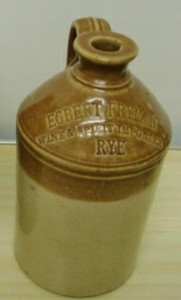
After his bankruptcy in 1848 the Dial was sold by his assignees as a public house. A further document states that the assignees of ‘Stephen Gilbert Fryman a bankrupt, sold the public house known as the Dial in Longer Street (now the High Street) to James Jenner, Gent of Portman Square, London for £495’, in 1854.
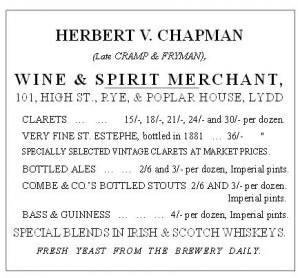
However bankruptcy only stopped him from trading for a short period of probably 12 months. By 1850 he was trading vigorously as a wine and spirit merchant, and in the House of Commons Enquiry into corrupt practices during the Rye election of 1852, Stephen Gilbert Fryman is listed as the major supplier of wines and spirits to the numerous Rye public houses and eating houses, who gave out free food and drink during the ‘treating scandal’ of that general election. At a property auction held at the George Inn six years later in 1858, Fryman, still trading as a wine and spirit merchant, purchased another property (now part of the museum) and land in East Street behind the Dial, for £165 from Eliza Turner, spinster of Bexhill. In 1863 and again in 1864 the Dial is listed and named as a fully licensed public house in the annual reports of the Rye Brewster Sessions in the Sussex Express. Unfortunately the licensee is not named.
Then in 1874, 25 years after his bankruptcy, Fryman re-purchased the former Dial from the executors of James Jenner, one of whom was himself, for £520. This action suggests that he greatly resented being made bankrupt and losing the former Dial public house to his creditors, and was determined one day to regain its ownership.
Finally in 1875 a mortgage describes the premises as: ‘kept for many years as a public house known as the Black Boy and Still, now the Dial, many years in the tenure of Stephen Fryman’. This is the last reference to the property as fully licensed premises. As far as is known it was never again in use as a public house, and by 1878 the premises were in the hands of his son Egbert Fryman described as a wine merchant.
In 1886 Stephen Gilbert Fryman, now described as ‘Gent of Chiswick’, sold the premises to John H E Cramp of Rye for £1,100, who then leased the property to Herbert Verral Chapman, brewer of East Guildford (later Chapman Bros). At that time Chapman owned or leased six licensed houses in Rye, including the Globe, Greyhound, Tower, Ferry Boat and London Stout House. Stephen Gilbert Fryman died in 1894 leaving his son Egbert to manage his interests. In 1901 the land at the rear of 101 High Street was conveyed to Chapman Bros, after it had been sold by Egbert Fryman for £400 in 1895.
Egbert Fryman was then an employee, or perhaps a partner of Chapman Bros and was, in 1899, instrumental in the rebuilding of the Ferry Boat Inn, Ferry Road, and in that pub’s reopening in 1900 as the New Inn. He also had a major role in overseeing and promoting the revamped London Stout House during those years. He was known to be quite vocal in opposition to the Rye temperance movement. By 1900 the former Dial public house had become a part of Chapman Bros wholesale storage and distribution network and an off-licence. In 1920 it was conveyed from Chapman Bros to Edwin Flynn, Brewers of Lydd, who eventually became part of the Style and Winch Brewery of Maidstone.
According to the Dictionary of Pub Names, in the 18th century the name ‘Black Boy’ was a common name for taverns and coffee houses, and was usually a reference to a personal servant of a rich person. By the 19th century it was more likely to portray a young chimney sweep. A ‘still’ is the apparatus at the centre of the distilling process by which alcohol is produced.
The ‘Black Boy’ is also thought to refer to Charles II, because of his dark skin and it is tempting to speculate that die hard royalists drank here and secretly toasted ‘the blackboy over the water’ during the Protectorate (1653–1659). The name most probably originated with a former tenant who was a royalist and supporter of Charles II. Apart from the Charles II connection there is also the possibility that the name referred to a black mooring buoy located in Rye harbour — but this is only speculation.
By the 1960s the premises were in the hands of Carlos and Thrale Ltd, described as ‘hirers of cocktail bars and equipment for parties’. The building is now the Rye Age UK shop.
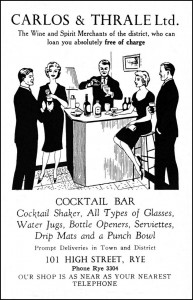
Other pub histories can be found in the book The Pubs of Rye, East Sussex 1750–1950 by David Russell. The book, illustrated with around 100 photographs, is in paperback, 282 pages, priced £13.99.

It is available at Martello Bookshop, Adams of Rye, Rye Tourism Information Centre, Rye Heritage Centre and Waterstones in Hastings. It is also available at www.hastingspubhistory.com, by email: hastings.pubs@gmail.com or phone 01424 200227.
I am collecting Rye pub memories and photographs for inclusion in any future edition.
By David Russell.
“Rye’s Own” May 2008
All articles, photographs and drawings on this web site are World
Copyright Protected. No reproduction for publication without prior
arrangement.